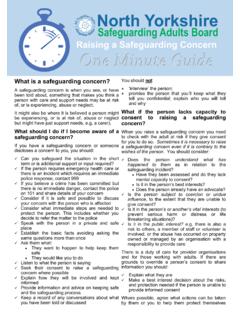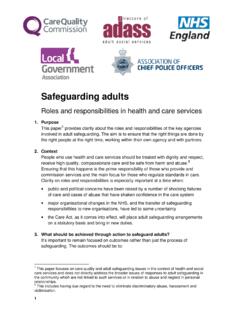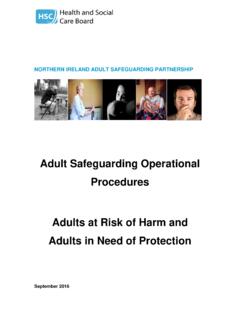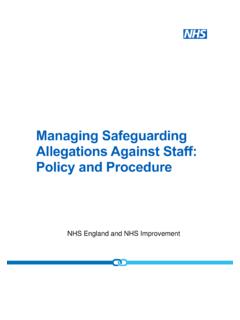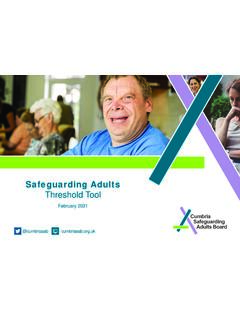Transcription of Safeguarding adults protocol: pressure ulcers and the ...
1 November 2018 Safeguarding adults protocol pressure ulcers and the interface with a Safeguarding Enquiry November 2018 DHSC ID box Title: pressure ulcer protocol Author: Chief Social Worker for the Department of Health and Social Care 18277 Document Purpose: Guidance Publication date: January 2018 Target audience: Health and social care practitioners and managers Contact details: Department of Health and Social Care, 39 Victoria Street, London SW1H 0EU You may re-use the text of this document (not including logos) free of charge in any format or medium, under the terms of the Open Government Licence. To view this licence, visit Crown copyright 2016 Published to , in PDF format only.
2 Safeguarding adults protocol 3 Contents Contents .. 3 Foreword .. 4 1. Introduction .. 6 2. Aim .. 8 3. Scope .. 9 4. Impact .. 11 5. Background .. 12 6. Definitions .. 13 7. Safeguarding Concern Assessment Guidance .. 14 8. Appendices .. 17 Appendix 1: Guidance for completing the adult Safeguarding decision guide .. 17 Appendix 2: Decision process .. 19 Appendix 3: Adult Safeguarding Decision Guide for individuals with severe pressure ulcers .. 20 Appendix 4: Body Map .. 23 Appendix 5: Adult Safeguarding concern proforma regarding pressure ulceration .. 24 References .. 27 Acknowledgements .. 28 November 2018 Foreword I am delighted to publish this guidance with the aim of assisting practitioners and managers across health and care organisations to provide caring, speedy and appropriate responses to individuals at risk of developing pressure ulcers .
3 Prevention of pressure ulcers is not only ideal but, in most cases, perfectly possible. Taking a proactive approach will reduce harm to individuals and secure efficiencies to the wider health and social care system. Where pressure ulcers do occur this guidance offers a clear process for the clinical management of the removal and reduction of harm to the individual, whilst considering if an adult Safeguarding response under section 42 of the Care Act 2014 is necessary. The guidance demonstrates that the focus on removing harm to the individual will usually be secured by speedy clinical intervention. Broader issues of overall quality of care, management of a service, and training of staff will be of significant interest to commissioners, and the regulator the Care Quality Commission, as well as Safeguarding Adult Boards and Quality Surveillance Groups.
4 There should be clear processes in every locality for communicating concerns to the relevant bodies. pressure ulcers , largely preventable, cause distress to individuals and their families, as well as creating additional financial pressures for the NHS. Whilst the treatment and response to pressure ulcers is a predominantly a clinical one, the prevention of them our ultimate goal is a shared responsibility. The reality is that many people at risk of pressure ulcers are receiving services that are commissioned, arranged and provided by non-clinical staff in the social care sector. It is vital that any assessment, including risk assessments, address the likelihood of pressure ulcers developing and what action must be taken to prevent them.
5 This will be as true for an individual living at home as those living in a regulated care setting. It is also vital that carers, whether family/friends or paid carers, receive training in the prevention and signs of developing pressure ulcers . Those responsible for carrying out assessments and arranging services need to be alert to this issue and have easy access to clinical advice to support care planning. The content of this guidance reflects the six principles of adult Safeguarding originally developed in 2011 and re-stated in the Care Act statutory guidance. I would urge everyone to familiarize themselves with those principles and ensure that their organisational procedures and practice are consistent with them.
6 This is a real opportunity to improve the lives of individuals and their families in a way that has the potential to significantly improve the quality of life for a great many people and I urge you to collaborate with partners at a local level to bring about positive change. Lyn Romeo Chief Social Worker for adults Safeguarding adults protocol 5 Update October 2018 Since the publication in January 2018 by the Chief Social Worker of guidance on pressure ulcers and the interface with a Safeguarding enquiry, the National Stop the pressure Programme published their recommendations in June 2018. One such recommendation is to no longer use the definition of either avoidable or unavoidable.
7 The Programme sets out their rationale that ceasing use of these terms will lead to all incidents being investigated to support organisational and system learning and appropriate actions. They hope that this recommendation will also move from a current position where much focus is placed on proving if an incident was unavoidable using a range of definitions in practice. The Programme notes that this is consistent with other categories of patient safety incidents in England. The impact of implementing this recommendation is that all incidents will need to be investigated resulting in greater numbers of pressure ulcers being recorded and reported by individual providers.
8 There will be likely impact on local NHS Contracts due to the existing approach being imbedded in the contracts. As a result, NHS Improvement and NHS England will be reviewing all relevant documents, including commissioning approaches, to support implementation of this recommendation. Trust Board will be reviewing local documentation and implementing the change in practice, including to educate all staff about the changes in practice. Finally, commissioners will be supporting implementation. To ensure consistency we invite practitioners and managers across health and care organisations to read the DHSC Safeguarding adults protocol in line with the Programme s recommendation to no longer use the definition of either avoidable or unavoidable but rather to investigate all incidents.
9 November 2018 1. Introduction This protocol will provide a framework for health and care organisations to draw on when developing guidance for staff in all sectors and agencies that may see a pressure ulcer . If the staff member is concerned that the pressure ulcer may have arisen as a result of poor practice, neglect/abuse or an act of omission, the local guidance should be clear about what steps they need to take and whether the local authority Safeguarding duties are triggered. From a governance perspective, each organisation that utilises this protocol will be responsible for ensuring that local guidance reflects the protocol is used appropriately and that is use monitored.
10 Safeguarding Adult Boards (SABs) and Quality Surveillance Groups (QSGs) will want to be reassured that this is the case. This protocol should be applied to pressure ulcers reported by anyone including care providers, clinicians, anyone undertaking Safeguarding enquiries, unpaid carers, relatives and individuals themselves, as any tissue damage resulting from pressure should be considered. This protocol has been developed and agreed in the broader context of the implementation of the Care Act 2014 and the drive towards greater integration between the health and social care systems. The core principle underpinning the Care Act is promoting individuals well-being.










